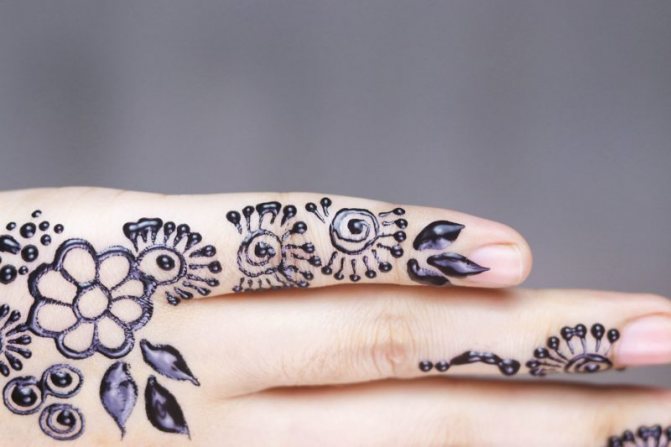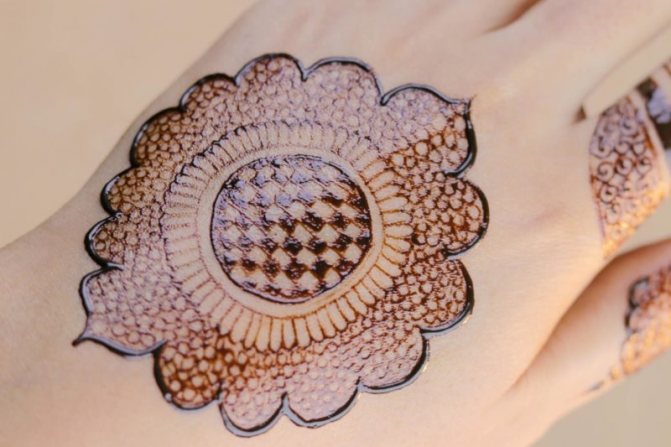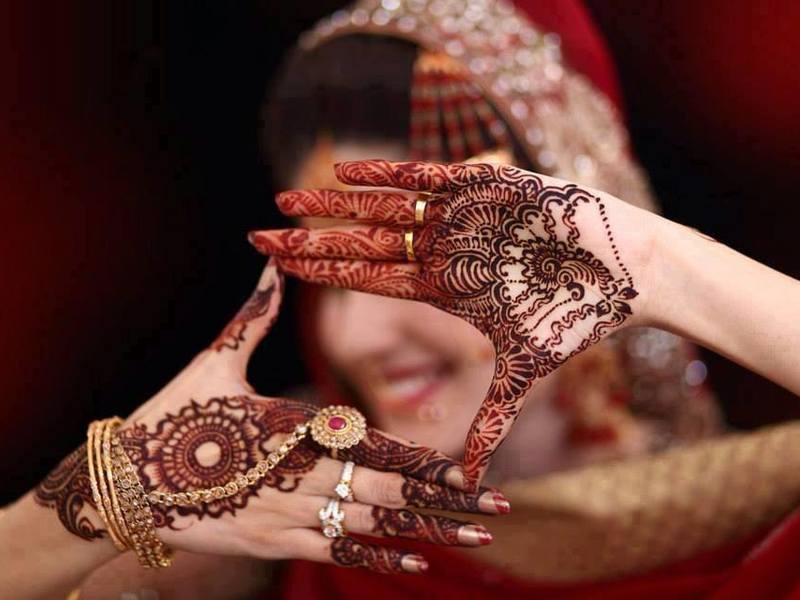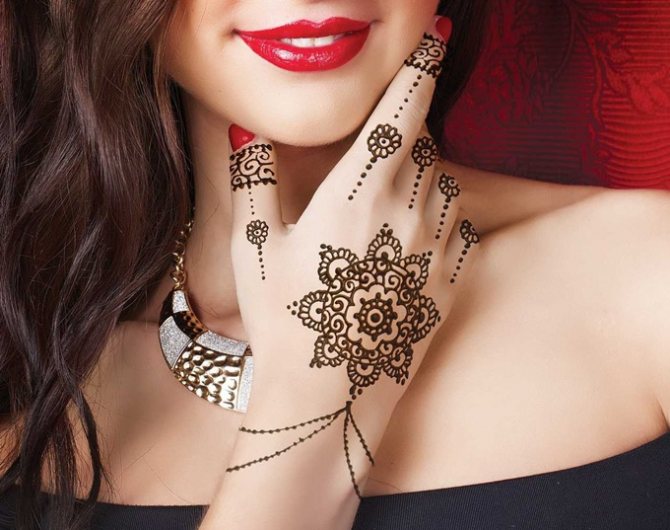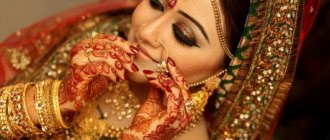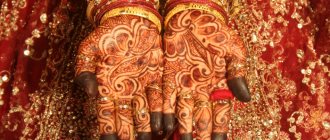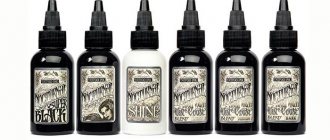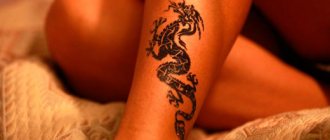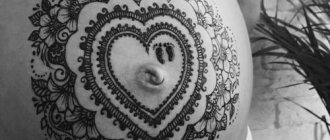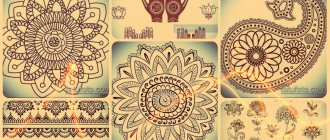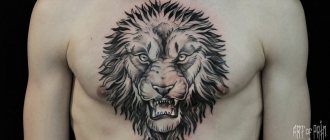Secret signs: mehendi - henna drawings November 19, 2012, 00:00 | Galina Zamyslova
18 have chosen.
I remember at school, after watching Indian movies, girls drew patterns on their palms with a ballpoint pen. The movies had songs and dances, the girls in them were bright and ornate, and the patterns were exquisite and mysterious. If I had known then that I should have just used my mother's henna, it would have been almost real! Painting henna patterns on the body is an ancient art and a secret language of symbols. Ancient Babylon, Assyria, Mesopotamia, Ancient Greece and the Great Roman Empire were known for henna painting, to which the beauties of those distant times devoted long hours...
Mehendi - henna painting on the body
Mehendi (mehandi) or mendi, mehndi or midi is the art of painting the body with henna patterns. Many believe that this art was born in India, but even in Ancient Egypt, noble ladies decorated their nails and the whole body with this pattern. In Central Asia and the East, henna also attracted men, who mastered this art to perfection, applying complex abstract patterns. But still, today, lace henna patterns on the hands are the most recognizable mark of India. The henna drawings are an integral part of Indian culture. To this day, mehendi is used in almost all celebrations and festivities and is part of many religious ceremonies, the main decoration of the bride at the wedding.
The symbols of mehendi
Originally, mehendi drawings served as a kind of talismans with magical qualities. Each element of the pattern or the whole ornament had its own, special meaning. A full deciphering of all the signs, alas, has not survived, but something can still be unraveled.
Some mehendi designs echo fabric patterns, and the juxtaposition of simple lines reflects the duality of life. The triangledepicted with the top up is a symbol of male activity and fire, and the top down is a feminine symbol of water and the grace of Heaven.
The star - symbol of hope, the square symbolizes stability, honesty and shelter, the octagon of two squares symbolizes protection. The cross - a cosmic symbol of the connection between heaven and earth, with a square overlaying it means the Temple with the doors open to all. Circle - symbol of integrity, but in India it still means a turn of life. The circle with the tongues of flame - is prakriti, that which develops, produces and gives birth to. The sickle of the moon - the newborn child, striving to grow, and Sun - the door of the universe, the entrance to the world of knowledge and immortality. Lotus - feminine symbol of generosity of the earth, the tree of life. Fruit and flowers - symbols of happiness, with flowers signifying the brevity of childhood and new life, and fruit the essence of immortality. Grapevine - A symbol of loyalty, which is always reaching for the light, but needs support.
Patterns of fine lines, arches, leaves, lotuses, peacocks, mangoes and various auspicious and religious symbols are usually applied. The patterns cover all the arms, sometimes reaching up to the forearm, and to emphasize the shape of the legs they draw mostly geometric floral patterns. For the first time mehendi patterns are applied to girls as early as 3-4 years old.
Mehendi for the bride
Since ancient times, the bride on the eve of the wedding was literally painted with henna patterns, initiating her into the mysteries of marriage. The drawing can be so intricate that it takes several days, but it's worth it! The more stable the drawing, the longer the celebration for the bride, because according to Indian tradition, the bride is free from all hassle while the wedding patterns are kept on her body! It's a beautiful tradition, don't you think? By the way, if there is any henna powder left over, it is buried in the ground to avoid infidelity of the future husband.
And during the wedding season, beauty salons work around the clock, and the streets of Indian cities are literally full of painted palms of brides....
The color of mehendi signifies the power of love in a marriage: the darker, the stronger the love. Mehendi protects against evil spirits, misfortune, illness and even death. Indian women believe that the more elegantly her hands and feet are decorated, the more admired she is by her husband and all his relatives.
Styles
Traditionally, mehendi is performed in one of four styles:
Arabic - floral motifs of the Middle East, resembling Arabic embroidery and without a specific pattern.
African (Moroccan) - the North African style of geometric figures with floral motifs. The pattern is clear, stylized and strictly follows the shape of the arms or legs.
Indian
Indian and Pakistani designs are complex and large, from palms to forearms and from feet to knees, creating the illusion of gloves or stockings. They consist of lines, ornaments and drop patterns interwoven into a lace pattern.
Asian
A combination of elements of the first and third styles is expressed in the mehendi of Indonesia and South Asia. The drawings differ only in the colored spots on the tips of the fingers and toes, sometimes completely covering the fingertips, the sides of the palms and feet.
All of these styles are very popular on their own and mixed with each other. The main thing is to like the person on whom it is applied! In Europe, mehendi came recently, but is very popular especially among musicians, models and anyone who wants to look in a special mysterious way. It's enough to put a small pattern on your forearm or hand and...
Mehendi is not a tattoo, it stays on the skin for about a month. Therefore, if the mood has changed, you can change the pattern, but only after 4-5 weeks! Therefore it is better to be more or less constant. It is believed that the right drawing, applied henna, brings peace, prosperity and health.
Try to draw something special yourself, your own, and let the mehendi drawing give you an amazing feeling of joy and happiness!
Galina Zamyslova, iledebeaute.ru
How long does mehendi last?
The time of application of modern mehendi depends on the complexity of the chosen pattern and the experience of the master. Because the drawing is applied directly on the skin (that is, the paint remains on the surface of the epidermis and does not penetrate into the deeper layers), the process takes only a couple of hours.
Mehendi lasts on the body for about a couple of weeks (25-30 days to be exact) until the epidermis is completely renewed. Then you can begin to make a new pattern. Patterns are applied not only to the palms of the hands and feet. Forearms, shoulders, wrists, ankles, neck, and even face are suitable. In general, paint all you want *wink*.
A short history of mehendi
The roots of mehendi date back to ancient Egypt where the rich and noble ladies were applying henna patterns to their faces, bodies and nails. Later, men also became adherents of such patterns. There, the same subjects decorated the bodies of pharaohs with paintings, which, according to the Egyptians, helped them in the afterlife. Subsequently, mehendi, the application of henna patterns on the body, became not only a priority for the rich nobility. It was also followed by the poor as henna became widely available.
Mehendi spread in Asia, the Middle East and North Africa. The inhabitants of India and Central Asia used natural henna powder, so the patterns had only brown and reddish hues. In North Africa, ash and charcoal were added to the henna, which gave the drawings on the skin a dark or even black color. By the way, in Morocco, pregnant women still wear mehendi on their ankles: it is believed that this way they will protect the future baby from the evil eye.

In Muslim countries, only married women and brides could wear this type of body decoration. According to the laws of Shariah, it was forbidden to put tattoos on the body, because it changed the body of a person granted by Allah. Especially the body of a woman. Muslim women who had henna patterns on their hands and feet hid them under gloves and socks because the henna beauty was for the eyes of her husband only. Such a drawing was considered an extremely intimate adornment designed to captivate and attract one's own spouse.
In India, mehendi was worn from the age of three. The privilege of henna patterns remained with the girls, although later men began to wear eye-catching painted patterns as well. As soon as a girl became a bride, the mehendi ritual took on a double meaning. Experienced, older female relatives would draw openwork patterns on the bride's arms, shoulders, neck, legs, and feet with wooden sticks, initiating her into the erotic secrets of married life.
You probably think that the disclosure of all the secrets will take a couple of hours at most. But it didn't. It was thought that the more patterns on a girl's body, the brighter, more skillful and beautiful they were, the more experienced and clever the bride became "in matrimonial matters". That is why it took more than 5 hours or even 2 nights to make such pictures. The remaining henna was buried in the ground (to avoid her husband's adultery).
Most likely, experienced female relatives did not just paint the poor bride firmly, knowing ahead of time what kind of being married would be like. There is a secret here, which, by the way, still works to this day: the longer the drawing is kept on the bride's body, the longer she will be officially removed from all household chores and responsibilities. Only pleasing her husband J There you go. I wonder who they have running the household while the young ones are having fun?
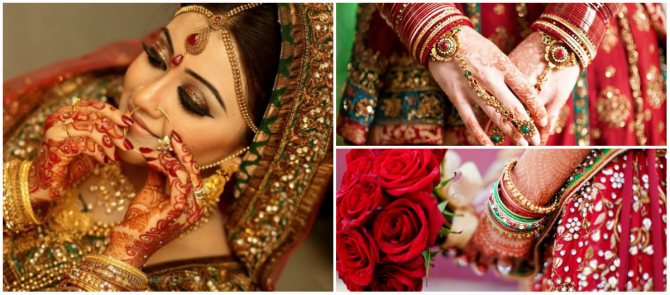

Of course, nowadays wedding mehendi is done faster, and both at home on their own and in a beauty salon. The secrets of married life are hardly discussed, but the pattern is left as intricate and bright, as it is an indication of how much the bride loves her future husband. Moreover, the more creative the pattern - the better for the girl.
What secrets does the picture in the form of a feather keep?
All body images attract attention to themselves, because it is a way to express themselves, to emphasize their individuality. When choosing a tattoo it is important to choose each element competently and combine them in a single scheme. Every stroke carries a meaning.
Mehendi in the form of a feather is very popular with modern people. Today, anyone can draw it, but several hundred years ago it was a special mark. Once upon a time, long ago it was the attribute of tribal leaders and warriors, who in this way showed perseverance, strength, courage and skill. Shamans also made use of feathers when they performed ritual dances. People believed that it helped them communicate with deceased ancestors, kinsmen and gods. Since then, it has been a symbol of immortality and a guardian against evil spirits. Later, women began to weave protective amulets called Dreamcatchers, which were hung over the cribs of infants to protect them from bad dreams. It is considered a powerful amulet against spoilage and the evil eye.
Tattoo with a feather could be worn only by great men of their time, who earned respect among the people by their actions and courage on the battlefield. Often this pattern was interpreted as a sign of a powerful and mighty man.
In the Indian style, men are given a picture in black tones. It goes perfectly with most religious ornaments.
Clergymen of Christian churches wore a ring on the hand, decorated with a combination of three feathers. This attribute meant faith, hope, beneficence and mercy. The ancient Greeks considered this part of the bird personified beauty and luxury, only people of the highest class could wear it. Many cultures associated this item for its weightlessness and lightness with the wind and air, so one often sees such an interpretation of henna mehendi with this image as:
- sublimity;
- creativity;
- flight;
- purity;
- freedom;
- inspiration;
- dream;
- tenderness.
Mehendi styles
In total there are four main styles of mehendi. However, no one forbids to generate them among themselves and get new creative ideas. After all, among other things, mehendi remains a potent talisman, saving from the evil eye, spoilage, granting success in business, and in all that is reflected in the patterns.
- Moroccan (African) style
Masters of North Africa work mainly with this style. The patterns clearly correspond to the anatomical lines of the arms and legs and are geometric and floral in nature. The drawings are very stylized. By the way, the Bedouins simply dip their palms and feet in henna without making any patterns as a sign of complete negation of everything, and at the same time, a commitment to the roots.
Here are some photo examples of the Moroccan style of mehendi:


- Arabic style.
Masters of the Middle East adhere to the Arabian style. They draw floral patterns in the style of Arabic painting and embroidery.
Examples of Arabic style:


- Pakistani (Indian) style.
Masters in India and Pakistan are happy to use their own, openwork, ethnic style. They have many peculiar application techniques, most often, each master has his own technique. Hands and feet are painted in such a way as to create the illusion of lace stockings and gloves.
Fine lines, ornaments, flowers, drop-shaped forms, tracery - all this is a sign of Indian mehendi. Perhaps the most striking and unusual patterns are found in this style, which you can see in the photo below:


- Asian style
Adherents of the Asian style (Indonesia and South Asia) call it a kind of eclecticism of Indian and Arabic styles. Mixing different elements is the main difference of the Asian style. Vegetal ornaments, dot patterns, painting of fingertips, sides of palms and feet - all this masters skillfully combine and put into practice


.
Today you can choose not only the style you like, but also create your own, taking as a basis any distinctive elements. The more individual your drawing will be, the more magical properties your biotatu will have.
In mehendi pictures are symbolic. That is why Korolevnam.ru magazine hurries up to tell you about the meaning of mehendi.
The rules of drawing henna pen patterns on the body
Patterns on the body look beautiful and stylish almost anywhere, but this picture is a real decoration for the back, foot, spine, shoulder, hand and neck. Men prefer massive elaborate ornaments executed in a single color. For guys it is a symbol of determination, courage, boldness, which characterized the warriors of Indian tribes. Tattoo protects against disease, trouble, helps to achieve victory and cope with the bitterness of defeat.
Girls like modest and concise henna drawings with feathers, in which there is no unnecessary piling up. For the most part, they are neat and stylish pictures. They serve as a talisman against spoilage, evil eye and execution of evil spirits.
In order to make a person's life easier and more pleasant, you must wear a necklace of this ornament. For them, it is a symbol that helps them find inspiration.
Depending on the color scheme, the tattoo may carry a different semantic load:
- black and gray - strong spirit;
- Red - victory over life's obstacles and circumstances, over enemies;
- blue and green - the desire for calm, stability;
- purple and violet - identifying integrity of the bearer of mehendi, his strong temper and tough nature;
- Orange and yellow - spiritual harmony, comfort, tenderness, absence of ambition and serious life principles.
Often men like to draw a feather with a skull. This pattern looks intimidating and its meaning is unusual - these two objects link the world of the living and the dead. Who can dare to do such a henna sketch? Most likely they are fans of esotericism, mysticism.
There are special elements that give the drawing a special meaning:
- A feather in flight means sadness, sadness, longing;
- A feather in flight - means sadness, melancholy, sadness, separation from a loved one, the other half;
- a cut object - the loss of something valuable, severe emotional pain, suffering, acknowledgement of one's defeat.
It is important that the attribute belongs to a certain type of bird:
- Eagle - wisdom and honor, courage and fearlessness, agility and strength, the ability to survive in any situation. The Indians believed in the power of this symbol and believed that a tattoo with it would help a person acquire the qualities and character of this majestic king of birds;
- from the phoenix - immortality, the beginning of a new life, renewal;
- owl - a sign of intelligence, protects from evil spirits, helps to survive. This mehendi is often applied by lovers of magic;
- Ostrich - a henna tattoo with such a feather indicates that a person loves truthfulness and justice. Many thousands of years ago, the Egyptians worshipped the great goddess of order and justice named Maat, who was always drawn and molded with this bird attribute on her head. No trial was ever held without this deity's image. Legends say that she was the one who decided where a person would go when they died.
- The Firebird - elegance, mysterious personality, physical and mental beauty;
- crane - a sign of eternal life;
- without the sign of belonging to any species - talent, courage, inner strength, faith, spirituality, freedom.
If the body image of a large massive feather, combined with birds pointing upward, then you have in front of you an elevated, freedom-loving person who goes forward to the goals set, despite all obstacles and difficulties.
The henna drawing of peacock feathers has a special meaning. This mehendi is associated with the shining sun and stars. Different peoples denote openness and spiritual purity with this sign. It protects from evil spirits, trouble, and life's problems. In the modeling business it is believed that this picture brings good luck.
Girls like to decorate their ribs, ears, abdomen, feet, neck with the peacock attribute. Most often, ladies hide their tattoos and do on closed areas. The owners of such patterns are honest, positive, patient and conscientious.
But sometimes the tattoo can indicate arrogance and vanity of its owner, so it makes a small and hidden in a closed area of the body.
Sexy and expressive looks mehendi henna in the decollete area. For this, it is better to choose a bright and rich plumage. On the scapula, collarbone, outer part of the thigh, ankle, arm ornaments in a realistic embodiment look beautiful. A small image on the finger or wrist looks stylish. The back, decorated with an image of a feather, emphasizes the grace and elegance of the owner. The ornament supplemented with flowers, birds and precious stones looks original.
You can choose mehendi according to your taste and always listen to your feelings and intuition, but don't forget about the meaning and sacred meanings of the symbols.
Eastern traditions are closely linked to the art of body painting. It is in these lands, it originated, lived a thousand years of history and came to us. Therefore, when choosing an ornament it is necessary to refer to the religion of these countries to learn the meaning of the pattern.
The meaning of mehendi tattoos
Flowers
Floral motifs are very popular in mehendi. They represent femininity, fragility and a rich inner world. Fruits and flowers act as symbols of joy and happiness.


Turkish cucumber
The Turkish cucumber (paisley, buta, tear of Allah) is the embodiment of fertility, development, movement. In ancient times, only the nobility could afford such a pattern. In India, this pattern is considered a wedding pattern and carries the wishes of well-being and prosperity of the nascent family. This pattern will bring happiness not only to brides, but also to all people dreaming of prosperity in life. By the way, small dots are often applied in conjunction with the Turkish cucumber as a symbol of the bride's love for her chosen one.


Grain
Grain symbolizes abundance, prosperity and happiness in the home. Therefore, it is sometimes depicted inside the Turkish cucumber in wedding mehendi.


Flower buds, stems, vines
Flower buds represent new life. Such patterns can also be applied by people in love. The curly stems have the same interpretation. Only they, in addition, protect against the evil eye and spoilage (the same effect is achieved by the swastika). Vines, on the other hand, represent the tenacity and perseverance of the person who chose it.


Lotus
Mostly represented by the lotus motifs are worn by brides. It is a symbol of purity, virginity, femininity. Young brides put it on their hands as a symbol of fertility, the convergence of male and female energy, fame, fortune and success. Pregnant women also depict in their mehendi lotus.


Birds
Birds in mehendi play a role. They symbolize height, speed, sky, flight, dreams, freedom and even excitement.
Feather
The image of a feather tells of the extraordinary and bright personality. Sunniness, love of life, free-thinking and willfulness are the main traits of the person who drew a feather.


Peacock
The peacock is a symbol of the sun, pride, beauty and grace. A person who chose the image of the peacock seeks to show his royalty, romanticism. Witnesses glory, greatness, happiness, wealth. This sign rightfully belongs to artists, poets, musicians - people who are creative and strive to know the truth. By the way, the earring also patronizes creative individuals, increasing their talent.


Owl
The owl is a symbol of wisdom, flexible mind, firmness of decisions and even power. In ancient times, only influential and wealthy people could afford such an image. However, even today, not everyone dares to apply the image of an owl.


Swallow
The image of a swallow gives people hope and encourages them. Symbolizes spring, happiness, success. Since ancient times it was believed that the swallow attracts good luck.


Elephant
Picture of elephant in mehendi also ambiguous. Elephant symbolizes strength, intelligence, wisdom, longevity, glory, victory, military prowess. In India, elephants have a special attitude. There they are a symbol of kindness and mercy of Buddha. It is no coincidence that Ganesha, the god of wisdom and innocence, carries the head of an elephant.


God Sri Ganesha
Sri Ganesha is an Indian god with the head of an elephant and the body of a child. He represents wisdom, prosperity, innocence, spontaneity and cheerfulness. The image of Sri Ganesha is worn by brides and pregnant women. Also suitable for all those who start a new business and hope for help from higher powers to achieve success.


Pisces
The image of a fish is chosen by people languishing in love desires. Put a picture of a fish on your palm, and the desired object will soon be caught in your net.


Snails, Shells
Snails and shells are pictured by people who would like to hide from life's troubles and troubles. The same goal is pursued by umbrella lovers.


Chariot
If you see a chariot on your hand, you know you're dealing with a flexible-minded and broad-minded person.
The Crescent Moon
The image of the crescent moon is chosen by young girls and brides, as it symbolizes the incredible beauty and tenderness.


Sun
The sun symbolizes immortality, the unknown, the mystery of existence and the wisdom of thousands of years.


Bracelets
Most often, women adorn themselves with bracelets. This way, they want to attract a partner. Or just to succeed in love.


Triangle
Protection from anxiety, natural disasters and disease is provided by the image of a triangle.


Octagon
People who have applied the octagon seek to fully protect themselves from all possible sides: north, south, east, west, and adjacent directions.


Stars: Hexagonal, hexagonal
Stars also carry information. Five-pointed stars represent five elements: earth, water, air, fire and sky (yes, that is the Indian division, do not confuse with Chinese feng shui). Therefore, such a star expresses the hope for divine help.
The six-pointed star is responsible for the harmonization of masculinity and femininity.


Om
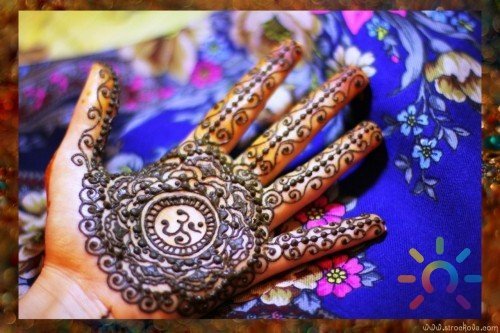

To decorate your palms or wrists, choose the drawing "Om", or "Aum".
Drawing means integrity, harmony of spirit and body, fusion of man and nature, body, spirit and speech, cognition of oneself.
It is recommended to apply such a drawing to women who aspire to know themselves internally, to realize their personality and achieve harmony with themselves.
It is best to start the pattern with this sign and complete it.
Read also:
St. Patrick's Day 2021: traditions, date, celebration
